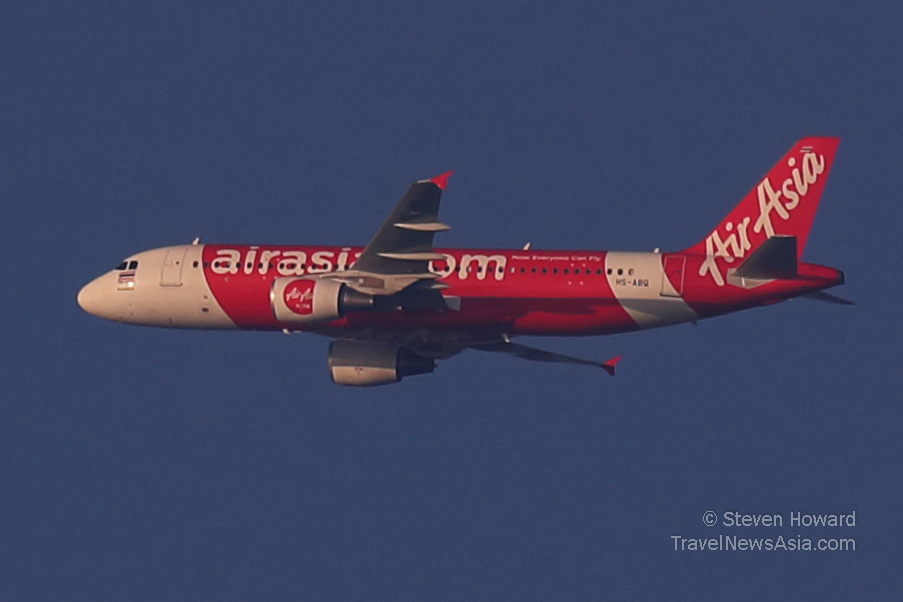|
(03 June 2022, 12:32 +07)
AirAsia has confirmed plans to install Descent Profile Optimiser (DPO) on its
Airbus A320ceo aircraft commencing from this month.
The enhancement to the aircraft�s onboard Flight
Management System (FMS) performance database allows the aircraft
to optimise the descent phase of the flight which subsequently
minimises the amount of time spent at an inefficient level off.
The software will reduce fuel
consumption and improve fuel efficiency by up to 0.75% of fuel
burn, which is equivalent to saving 101 kgs of CO2 emissions per
flight.
Over a year, the modification could reduce CO2 emissions by over 221 tonnes per
aircraft, per year, representing a considerable contribution to
more sustainable Flight Operations.

Thai AirAsia A320 reg: HS-ABQ flying from DMK to CEI. Picture by Steven Howard of TravelNewsAsia.com
AirAsia is installing DPO initially on 17 aircraft,
which will save 3,764 tonnes of CO2 per year or the equivalent of
62,700 urban trees planted based on the US EPA�s Greenhouse Gas
Equivalencies Calculator.
�As the travel industry begins to recover
and we expect to get back to pre-pandemic levels by the end of
this year, it is important that we review our climate strategy and
put in place new mechanisms and processes that will help to minimise the environmental impact of our flight operations.
Installing the new flight operations optimisation solution for our
current A320ceo aircraft allows us to reduce our carbon footprint
for the short and medium-term as we continue to gradually upgrade
our fleet to the higher capacity and more fuel-efficient A321neo
in the longer term,� said Bo Lingam, Group CEO of AirAsia Aviation Group. �Given the reality of climate change and the
airline industry�s contribution to emissions, reducing our carbon
footprint is currently one of our top sustainability priorities
and we look forward to further reducing an additional 221 tonnes
of CO2 emissions per aircraft each year with the DPO system we are
implementing. We remain committed to ensuring not only that we
build a sustainable airline but also align with the aviation
industry�s sustainability goal to reach net-zero by 2050.�
Besides the DPO, AirAsia has implemented several
other key efficiency initiatives to reduce fuel consumption and
carbon emissions such as One Engine Taxi (procedure to operate one
engine during the taxi phase of flight instead of both engines),
Idle Reverse Landing (a procedure that uses idle engine thrust
upon landing instead of powered thrust to reduce noise and fuel
burn) and the Required Navigation Performance-Authorisation
Required (RNP-AR) approach (a procedure that uses the aircraft�s
advanced navigation capabilities instead of conventional
ground-based equipment for the shortest landing approach).
In
2021, those measures enabled AirAsia to avoid emitting 11,175 tonnes of carbon dioxide, which is equivalent to planting 186,250
urban trees.
See also:
Hotel Waste, Single-Use Plastic and Climate Change - HD Video
Interview with WWF.
See also:
Thailand
Yacht Show Pattaya 2022 - Interview with Andy Treadwell, CEO of
Verventia,
iAqua
Adventures Interview with Nick Murphy at Thailand Yacht Show 2022
in Pattaya,
Jetboard
Thailand Interview with Marilin Poonsiri at Thailand Yacht Show
2022 in Pattaya,
TYS Pattaya
2022 Interview with Khun Sutiwas Chaisrivichiean, MD of MF Group
(Thailand),
Is Siam Seaplane Ready for Take Off? Interview with Dennis Keller,
Chief Business Officer,
New CEO at Pattana Sports Resort in Chonburi, Thailand - Interview
with Bodintorn Juangroongruangkit, Sport
and Fitness Training at Pattana Sports Resort in Chonburi,
Thailand - Interview with Craig Wood,
HD Video Interviews from Miss International Queen 2022 in Pattaya,
Thailand and
Mövenpick Siam Hotel Na Jomtien Pattaya - Interview with Dmitry Chernyshev, GM.
|
Headlines: |
|
|
